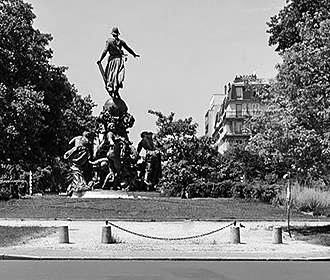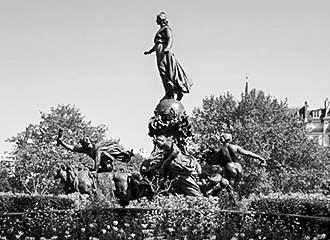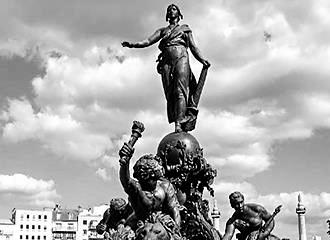History of the Place de la Nation
This historical square was originally known as the Place du Trone as it had a throne in it, then a guillotine during the French Revolution, and lastly an impressive statue you can still admire today.
The start of Place du Trone
When you look back at the history of the Place de la Nation, the square was originally named the Place du Trone, which generally translates to Place of the Throne in English, and this was due to the fact that a throne was actually put in place in 1660. And this was erected in the square in the July of that year ready for the arrival of Louis XIV and Maria Theresa of Spain after their marriage.
At the time, this square in Paris was actually located in countryside outside of the city limits, yet in the 1780s the very unpopular Wall of the Farmers General, or Mur des Germiers Generaux in French, was being constructed from the designs of the architect in charge, Claude Nicolas Ledoux.
Now this wall was designed to have gates in order to obtain taxes on goods entering the city, and the one located here was called the throne gate with its impressive columns, or Colonnes de la Barriere du Trone, as they are called. And these can still be seen today close to the Place de la Nation along with the two pavilions that were erected called the Barrier du Trone or Pavillons du Trone.
During the French Revolution and the Reign of Terror
However, during the French Revolution and the Reign of Terror after the monarchy had fallen in 1792, the Place du Trone had its name changed to the Place du Trone-Renverse, which generally translates to the Place of the Overthrown Throne, and instead of a throne, after a while a guillotine was placed in the centre of the square.
The guillotine we mention here was originally erected within the Place de la Bastille square, but with much uproar from local residents, it was subsequently moved to the Place de la Trone-Renverse. And unfortunately, this one guillotine alone saw the beheadings of over 1300 people, who were just thrown into pits within the Picpus cemetery located nearby, which included the Martyrs of Compiegne, the Carmelite Nuns.
From the 1800s and the change to Place de la Nation
It was then during the reign of Napoleon Bonaparte that the name of the square reverted back to the Place du Trone in 1805, and still with the same name, in 1841 during the reign of King Louis Philippe, an elephant statue was meant to be placed within the square, which had initially been meant for the Place de la Bastille, yet this never happened due to lack of funds.
It was then on the 14th July 1880, which is the anniversary of the storming of the Bastille, that the square was renamed Place de la Nation, and this has remained the same ever since, and a monument to the Triumph of the Republic was ordered for the square.
Originally a temporary sculpture was put in place prior to this impressive monument you can see today, and inaugurated on the 100th anniversary of the Republic, a pond with crocodiles that spat water was added in 1908, however these were melted down during World War II when Paris was under occupation.
Then, the pond was removed when the new RER line was being put in place beneath the Place de la Nation in 1960, so, today you can just see the monumental statue group sculpted by Jules Dalou.


